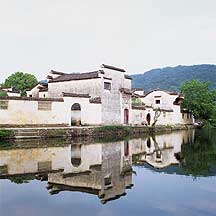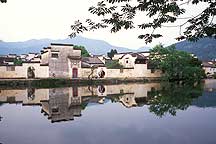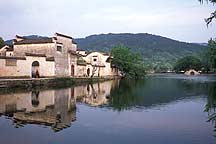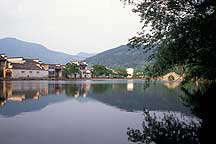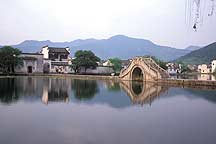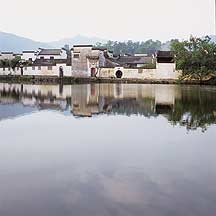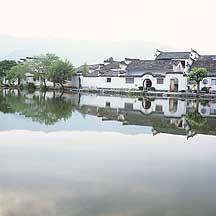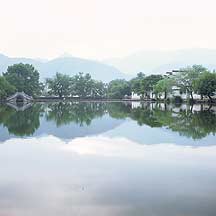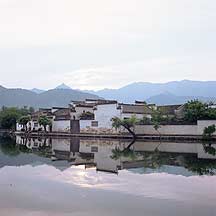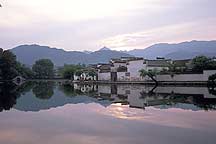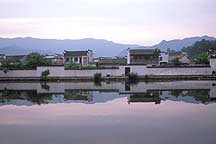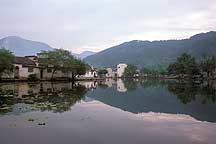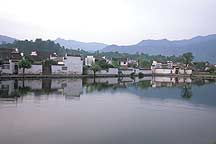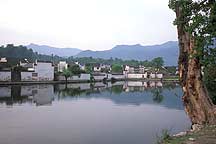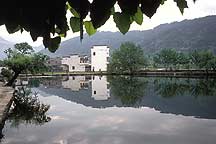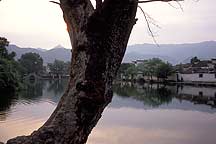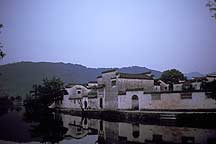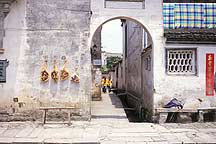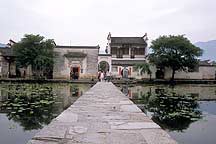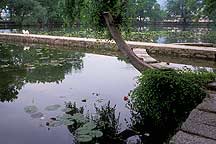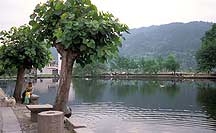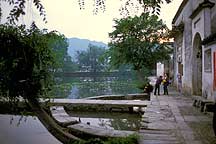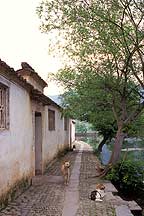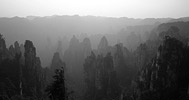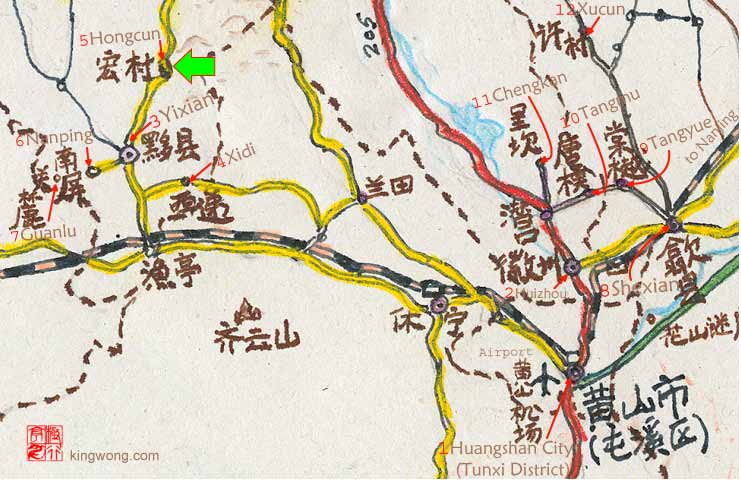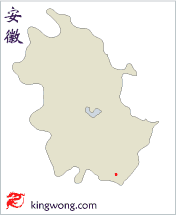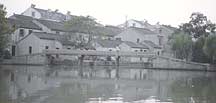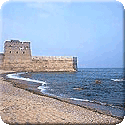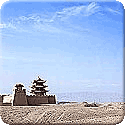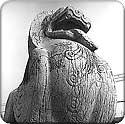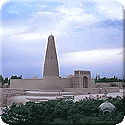Travel Information
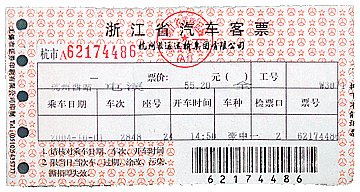
Getting There:
Like 西递Xidi, 南屏Nanping, and 关麓Guanlu, the other villages that I visited in the neighboring area, 宏村Hongcun village is located in 安徽Anhui Province, 黄山市Huangshan City, 黟县Yixian County.
To get to Hongcun, one usually stops in 屯溪区Tunxi district,
the governing seat of the city, and the name of the city before the extremely popular Huangshan mountain took the title.
This is the third time (2006) I was here. I travelled here in 2001 to climb 黄山Huangshan Mountain. Then, in 2004 I visited 棠越Tangyue and 唐模Tangmu village in 歙县Shexian county, and 西递Xidi in 黟县Yixian county. In each time I took the long-distance bus to Tunxi from 杭州Hangzhou, the provincial capital of 浙江Zhejiang,
and each ride was shorter and better - from 8hrs to 6hrs to 4hrs on better and better road.
You can get to Tunxi by plane but only through domestic flights. The airport is within the Tunxi district. By train and long-distance bus is very easy, Although you still need to get to a major city (usually a provincial capital, like Hangzhou or Wuhan) close to Huangshan city first as it is not a major city.
Hongcun is in Yi county, so one usually get a ride from there to the village. Foreigners, or at least non-chinese, need to get a permit to see these places. The permit can be obtain from Tunxi's PSB. As I have never looked at one, I don't know what is involve. Inevitably, there is a fee, which I had read to be about 60 yuan. Just be sure that the permit has the places listed on the permit.
Transportation:There are buses to both 黟县 Yixian (Y9 and takes about 45mins - 60mins in 2006) and 歙县 Shexian (Y5 and takes about 30mins in 2006) counties from outside 屯溪Tunxi's bus station. Be aware that the counties are in the opposite directions, so confirm with the driver that it is going in your destination. From Yixian, there are public buses (Y2 and takes about 30mins in 2006) to the village to the village. These buses normally waits from across a short stone bridge not far from the bus station.
Besides going to 宏村Hongcun, the buses also go to neighboring villages such as 西递Xidi, 南屏Nanping, and 关麓Guanlu. Signboards with the name of the villages are usually placed on the driver's front window; if not, confirm with the driver that it is going to your village. If you are in a hurry and there is no public buses there are always plenty of minivans for hire that will take you there (about Y15).
Other alternatives are to hire a van in Tunxi and go straight to the village. This may cost alot more (probably about Y100), but if you have several people this may be much faster and easier.
Accomodations:
In Huangshan city (Tunxi District):Huangshan city is one of the most popular tourist city in the country, and as so all sorts of accommodations are readily available. For those who have plenty of money to spent, you wouldn't need me to point you to the hotels. For those in the lower category, there are too many places one can choose to stay. Usually one does not need to go look for them, because as soon as you step down the bus or out the station, the locals would gather around and introduce their good rooms to you. One woman convinced me and I followed to her guesthouse. The place was a few minutes walking distance from the bus station, a two-story building below a slight slope from the street. Like many similar places, it was a home that was converted to a guesthouse when tourism got big here.
The ground floor belongs to her brother. It also has rooms for rent as well as a small eating place where there is a TV, so all the children gathered there in the evening. The second floor belongs to another brother, which also rent out rooms. Being the youngest, the third and least appealling(it has the best view of the all the laundry hung from the rooftop through the open ceiling) floor went to my proprietress. She has 5 rooms - two with private toilets and showers, the other 3 shared a public toilet and shower. Depending on the day and time of year, the large rooms can go from Y40 on a common day to over Y100 during the tourist season and on a national holiday. The smaller rooms go from Y20 - Y40.
My proprietress and her husband (who works in another hotel) used to live on the same floor but had since moved down to the ground floor. I have never recommended a place, but since I was here twice and found the proprietress to be very friendly and the rooms very clean, I am listing it below:
吴丽珍 - 黄山市屯溪区环城北路4号
电话:05592345209
手机:13855915644,13033123000
She accepts anyone but only speaks Chinese. Her pretty and assertive daughter may know some words of English. But I think hand gestures is enough to get by the day.
In Hongcun village:Family-style guesthouses and hotels are easily available here. The cost was usually Y20 and up. Nanping had about a thousand residents in 400 households. So it is a decent size village with enough activities to keep you busy for a day. During the high seasons, there can a large number of tourists. At the time the village hosted two art schools, so expect plenty of students.
There are plenty of hotels outside and inside the village, as well as many family-style guesthouses. Living in local homes is much cheaper (about Y20 - Y30 near the edges of the village or Y50 and up if right on the 月沼 Yuezhao (Crescent lake) or 南湖Nanhu (South Lake) and much more rewarding than hotels, but accommodations and privacy are limited. I lived on one guesthouse right near where the water enters the village from the 西溪Xixi stream on the west end of the village. The rooms are clean but spare: no TV or phone. The small but nice communal toilet and shower with evening hot water is outside. Mr. Wang will fire up the boiler with burning wood whenever you are back from a day's sweat around the many intricate houses and feel like taking a shower, but no bath though.
Below is the address:
汪灶林
上水圳05号
Mr.Wang only speaks Chinese, but will be glad to take anyone. He will also cook your breakfast, lunch and dinner, if you like, and proudly show you his water garden and pavillon where you can eat while admiring the goldfishes and carps looking at you.
There are also rooms that are centuries old, so if you are in the mood you may also rent one. While strolling along the Crescent lake on my second day here, the old woman took a break from washing and came over to me to ask if I needed a room. I replied that I already have a room. She smiled and reminded me of the beautiful pool here; to live beside it would be a thing to remember. I nodded and followed her into her large house. We passed over the arched doorway and stepped into what may had been the guestroom, the primary room where guests are hosted, but is now usually served as a eating room. We left this room through a narrow doorway on the left and enter the rectangular courtyard. The courtyard was stone-paved and on it were some small trees and flowers on pots and some furnitures and screens.
She openned a door to a room on the side and I stepped in. It was a small dim room. A single barebulb was hanging on the ceiling and she pulled it on. The ancient bed sat in front of me. You see it all the time: in films, in books, in the museums. It shapes like a legged vertical box with one of its four sides open; on the frames were delicate wood carvings. The whole construction was of wood, and it showed their age through traces of human touches that slowly changed the tones of the otherwise even monotonous finish. Two pink curtains hung on each sides, two embroidered pillows lay on top of a neat bed padding. In the morning you wandered through the alleys and marvel over the intense architecture; at night, you would like to return to the quiet pool and reflect, then move on through the maze of rooms and hop onto a bed that fit the reputation of the whole place.
This is what you came here for. Soon the old woman asked whether I liked the room. I openned the window door to look outside at the courtyard. If only there were plum trees and magnolias blooming; if only there was a large rock; If only this interior was more alive. I told her I would think about it and come back if I decided to rent it.
Food and Drinks:
Food in the village are the homemade style. All your hosts will cook for you with any fresh produce from the market. Since the village isn't very big, everyone tries to be unique, and many have inherited recipes. There are all sorts of things you can try out, like the egg rolls that a woman makes on the street with a hot plate, various breads, crackers and cakes, and the very thin pancakes that have various favors, like corn, mellow, apple and 20 others that I couldn't remember anymore. But you will meet these as you walk around the area.
Shopping:
The same stuffs you see in Tunxi, plus the intricate wood-carving panels. Don't expect them to be authentic (these are not made during the Ming or Qing dynasties nor probably 50 years ago, although the carvings maybe as good or even better), unless you really know these things. But if you really like them, buy it. They make great show pieces.
Bank:
There is a 中国农业银行Agricultural Bank of China inside the village. You may exchange major foreign currencies for 人民币Renminbi here. To exchange traveler's checks for RMB, you need to go to a major Bank of China. I don't remember whether there is a Bank of China outside the village where the bus station is. If there is one, they might take the traveler's checks since this is a popular international tourist area; otherwise you need to go back to the Bank of China in Tunxi.
Internet Access:
I remember there is a internet cafe in the village. I am quite sure there is one across the bridge.
Entrance Ticket:
80 yuan (2006).
Activities:
The village is relatively quiet at night, but across the stone bridge area is very lively. There are many vendors selling food and gift items, and there are music. No one really check your tickets at night but always hold on to it til you are done with the place for good.
Miscellaneous:
Foreigners or non-Chinese, need to get a permit to see these places. The permit can be obtain from Tunxi's PSB. As I have never looked at one, I don't know what is involve. Inevitably, there is a fee, which I had read to be about 60 yuan. Just be sure that the places are listed on the permit.
